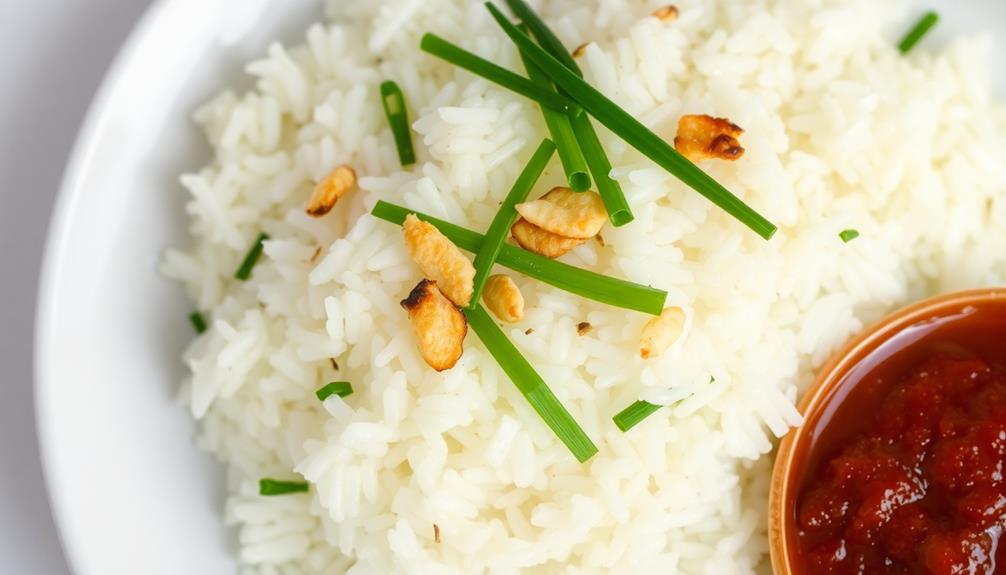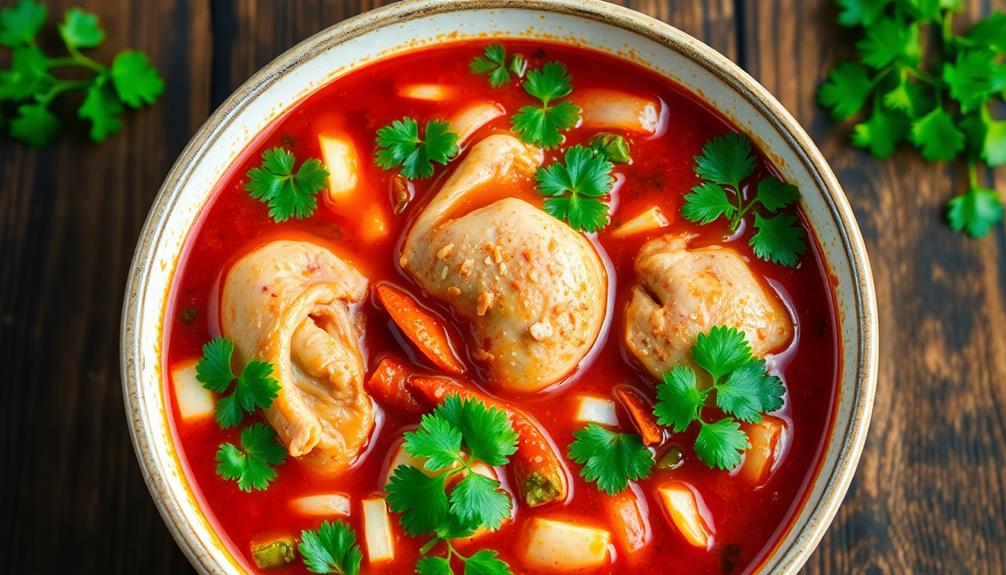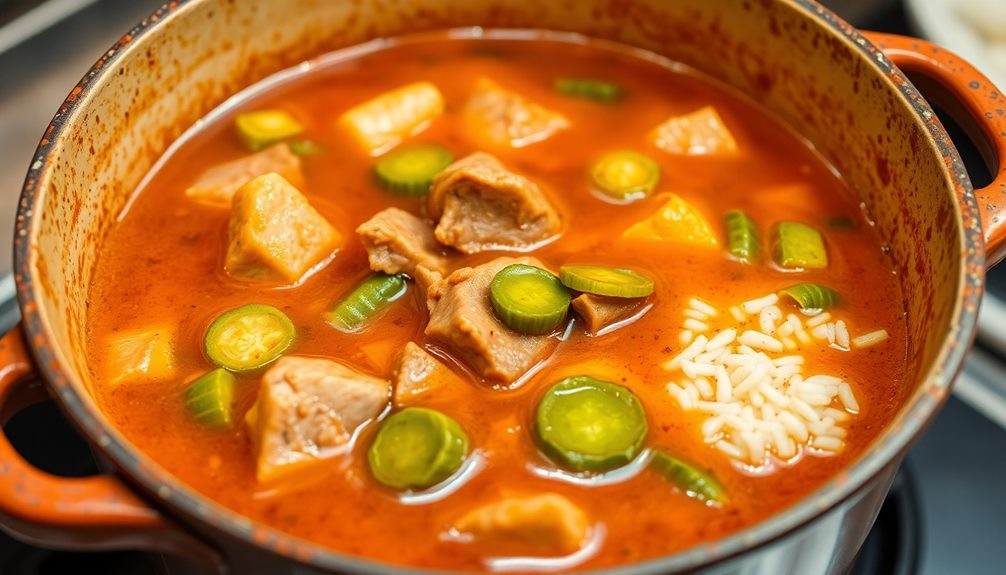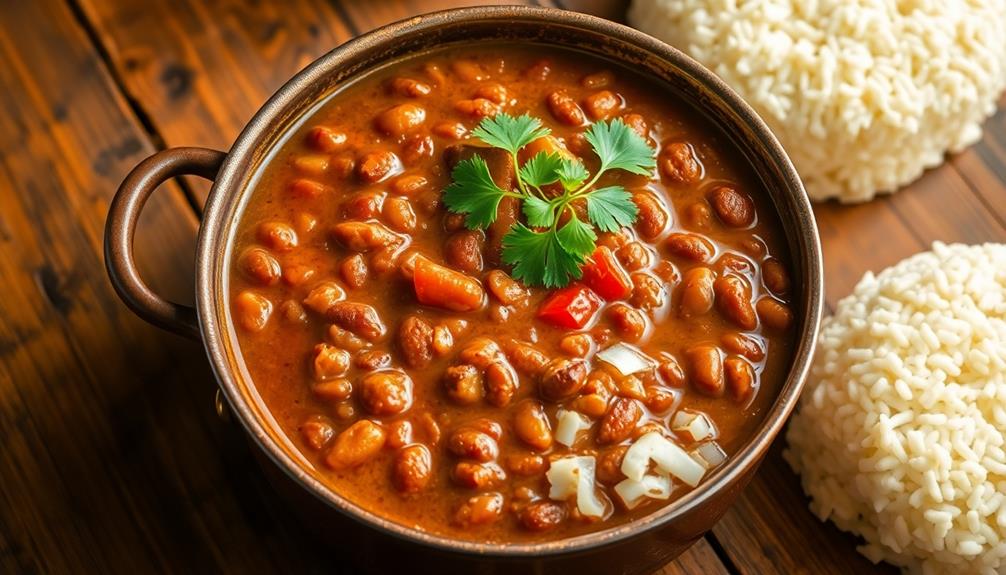You'll love the vibrant and flavorful taste of Nigerian Coconut Rice, a beloved dish passed down through generations. This creamy side combines long-grain white rice with rich coconut milk, aromatic spices, and fresh ingredients. The result is a tropical twist on a classic that'll delight your senses. You can even boost the nutrition by adding nutritious chia seeds. With its harmonious blend of flavors, Nigerian Coconut Rice is a crowd-pleasing dish perfect for gatherings or as a satisfying meal. Explore the rich culinary heritage of West Africa and discover the magic of this unforgettable dish.
Key Takeaways
- Nigerian Coconut Rice has a rich history in Nigerian cuisine, passed down through generations and celebrated at special events.
- The dish combines coconut milk with long-grain white rice, creating a creamy texture and a unique flavor profile.
- Aromatic ingredients like onions, garlic, and spices like ginger and curry powder enhance the overall taste of the dish.
- The cooking process involves sautéing the aromatics, simmering the rice in coconut milk, and fluffing it for the perfect texture.
- Nigerian Coconut Rice offers a delightful and unforgettable dining experience, showcasing the vibrant flavors of West African cuisine.
History

Coconut rice has a rich history woven into the culinary tapestry of Nigeria. This beloved dish has been a staple in Nigerian kitchens for generations, passed down through families with pride and care. Its origins can be traced back to the nation's coastal regions, where the abundance of coconut palms provided the key ingredient that gives this rice its distinctive flavor and creamy texture.
Over time, the recipe has evolved, with different regions and communities adding their own unique twists. Some might include aromatic spices like ginger or turmeric, while others might incorporate local vegetables or proteins.
Regardless of the variations, the essence of coconut rice remains the same – a comforting and satisfying side dish that complements a wide range of Nigerian main courses.
Today, coconut rice is enjoyed not just in homes, but also at celebrations and special events, where it often takes center stage as a cherished part of the Nigerian culinary heritage.
Recipe

Nigerian Coconut Rice
Coconut rice is a beloved dish in Nigerian cuisine, known for its aromatic, creamy, and flavorful profile. This delightful recipe combines the richness of coconut milk with the nutty, slightly sweet taste of rice, creating a harmonious blend that tantalizes the taste buds.
For an added nutritional boost, consider incorporating chia seeds into your coconut rice, as they provide essential omega-3 fatty acids and fiber.
The key to achieving the perfect Nigerian coconut rice lies in the careful selection and preparation of the ingredients. Each component plays a vital role in crafting this delectable dish, ensuring a truly authentic and satisfying culinary experience.
Ingredients:
- 2 cups long-grain white rice
- 1 cup coconut milk
- 1 cup water
- 1 teaspoon salt
- 1 tablespoon unsalted butter
- 1 onion, diced
- 2 cloves garlic, minced
- 1 teaspoon ground ginger
- 1 teaspoon curry powder
- 1/4 cup chopped fresh parsley (optional)
Cooking Instructions:
In a large saucepan, combine the rice, coconut milk, water, and salt. Bring the mixture to a boil over high heat, then reduce the heat to low, cover, and simmer for 20-25 minutes, or until the rice is tender and the liquid is absorbed.
While the rice is cooking, melt the butter in a separate skillet over medium heat. Add the onion and sauté until translucent, about 5 minutes. Stir in the garlic, ground ginger, and curry powder, and cook for an additional 2-3 minutes, or until fragrant.
Once the rice is cooked, fluff it with a fork and gently fold in the sautéed onion mixture. If desired, garnish with chopped fresh parsley before serving.
Tips:
For an even creamier texture, you can add an additional 1/4 cup of coconut milk to the rice mixture.
Additionally, consider toasting the rice briefly in the skillet before cooking to enhance its nutty flavor. Lastly, feel free to experiment with different spices or herbs to personalize the dish to your taste preferences.
Cooking Steps
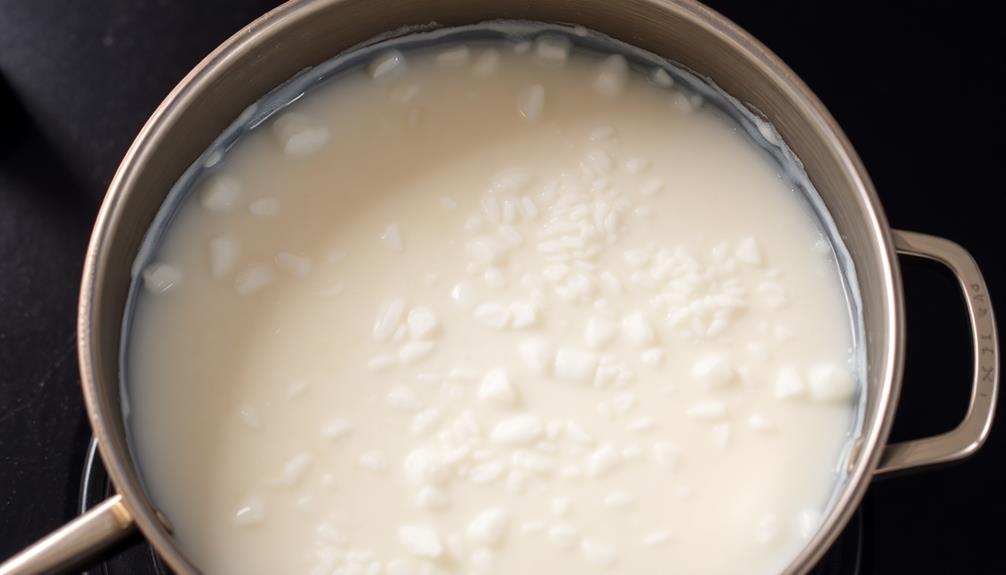
First, you'll want to rinse the rice thoroughly before cooking – this helps remove any excess starch.
Next, sauté the onions and garlic in a bit of oil until fragrant.
Then, pour in the coconut milk and let the flavors meld together as you add the rice and seasonings.
Simmer everything gently until the rice is tender and cooked through – the result is a delightfully creamy and coconutty dish!
Step 1. Rinse Rice Thoroughly Before Cooking
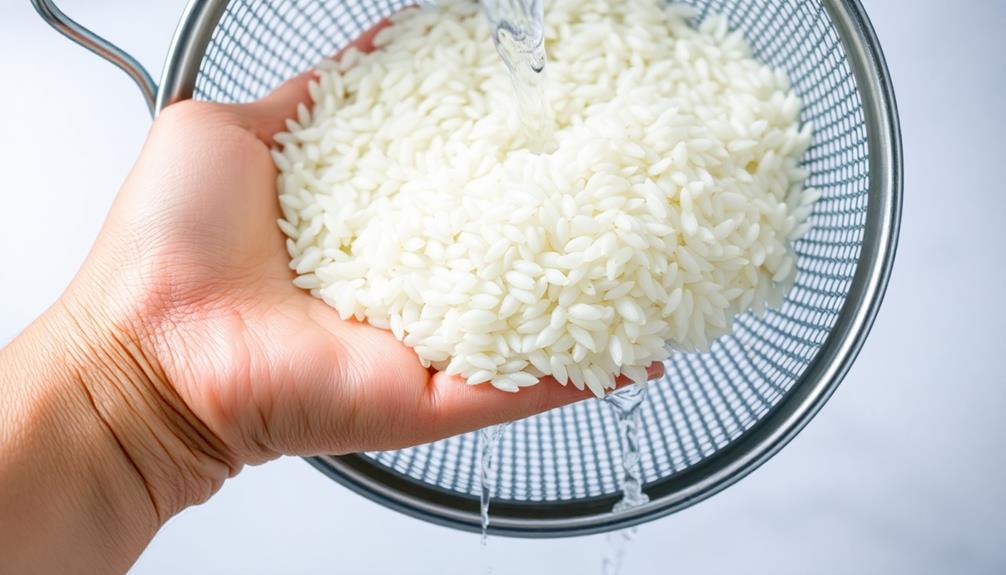
Before cooking the rice, it's important to rinse it thoroughly. You don't want any dirt or debris ending up in your delicious Nigerian coconut rice!
Grab a fine-mesh strainer and place the rice inside. Run cool water over the rice, gently swishing it around to release any impurities. Keep rinsing until the water runs clear – this helps remove excess starch, ensuring your rice won't be sticky or gloppy.
Once the rice is clean, you're ready for the next step! Grab your pot and let's get cooking.
First, add the coconut milk, broth, and seasonings. Bring the mixture to a boil, then reduce the heat and let it simmer.
Now, carefully stir in the rinsed rice. Cover the pot and let the rice cook until it's tender and the liquid is absorbed, about 20 minutes.
Fluff with a fork and serve hot. Enjoy the fragrant, flavorful results of your hard work!
Step 2. Sauté Onions and Garlic
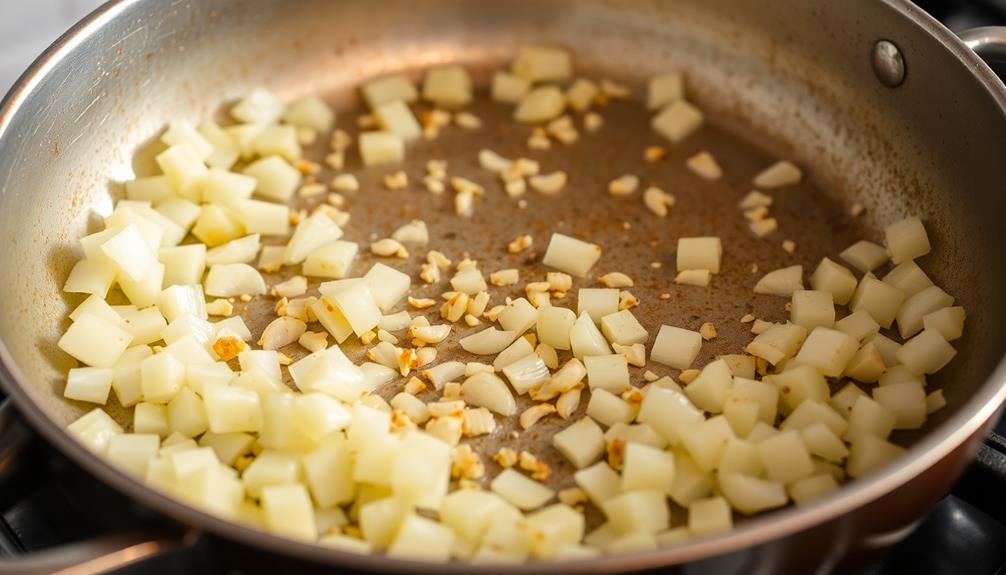
To start, heat a bit of oil in a large skillet over medium heat. Once the oil is shimmering, add the diced onions and minced garlic.
Sauté these aromatics, stirring frequently, until they become fragrant and the onions start to soften, about 3-5 minutes. Adding a touch of compound butter recipes can elevate the flavor even further, enhancing the overall dish.
The onions and garlic will create a delightful aroma that will fill your kitchen. As they cook, they'll become translucent and take on a slightly golden color. This is exactly what you want – the onions and garlic will infuse the rice with incredible flavor.
Be sure to keep a close eye on the skillet, as you don't want the garlic to burn. Burnt garlic can taste bitter, so you'll want to remove the skillet from the heat if the garlic starts to brown too quickly.
Once the onions and garlic are ready, you can move on to the next step in creating your Nigerian Coconut Rice.
Step 3. Add Coconut Milk
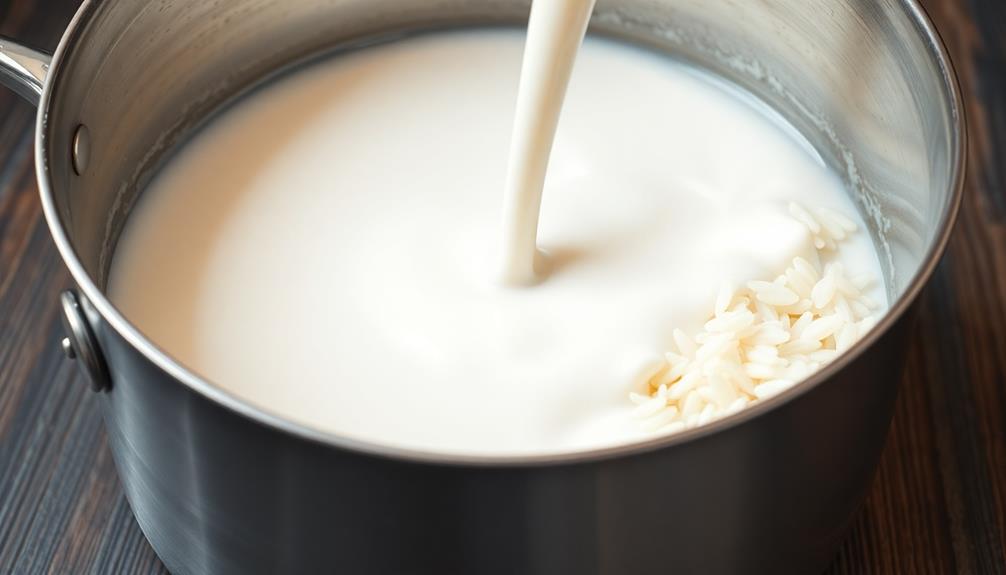
With the aromatic onions and garlic sizzling in the pan, it's time to add the rich and creamy coconut milk. Carefully pour in the coconut milk, watching as it swirls and combines with the fragrant vegetables.
Stir the mixture gently, allowing the coconut milk to infuse the dish with its luscious, tropical flavor.
Now, it's time to season the coconut rice to perfection. Add a pinch of salt, a dash of pepper, and a sprinkle of your favorite herbs.
Stir everything together, ensuring the seasonings are evenly distributed. As the coconut milk simmers, the rice will start to absorb the flavors, creating a harmonious and mouthwatering blend.
Resist the urge to overcook the rice, as you want it to retain a fluffy and light texture.
Keep an eye on the pot, stirring occasionally, until the rice is cooked through and the coconut milk has thickened slightly. This will create the perfect balance of creamy and flavorful coconut rice, sure to delight your family and friends.
Step 4. Add Rice and Seasonings

Once the coconut milk has been added, stir in the uncooked rice. You'll love how the rice soaks up all that delicious coconut flavor!
Sprinkle in some garlic powder, onion powder, and a pinch of salt and pepper. These seasonings will really make the rice pop with taste. Stir everything together until the rice is evenly coated.
Next, bring the mixture to a boil. Once it's boiling, reduce the heat to low, cover the pot, and let the rice simmer for about 20 minutes. Resist the urge to lift the lid – you want to keep all that steam trapped inside to cook the rice perfectly.
When the time is up, fluff the rice with a fork. Look at that – the grains are tender and infused with coconut goodness!
Serve this fragrant coconut rice as a side dish, or enjoy it on its own. Either way, your taste buds are in for a real treat. Get ready for lots of "mmms" and "yums" around the table!
Step 5. Simmer Until Rice Is Tender
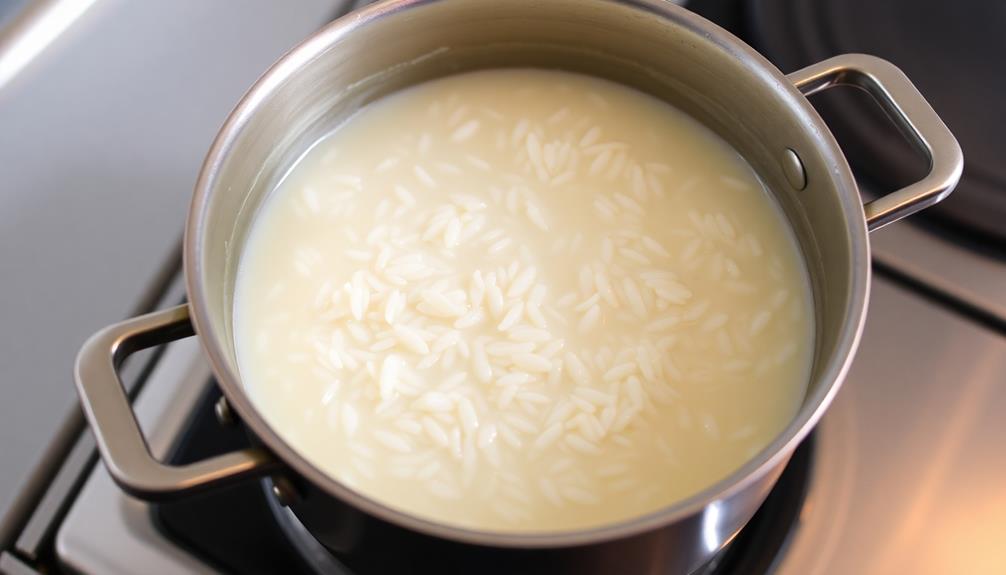
Once the rice and seasonings have been added, bring the mixture to a boil.
Reduce the heat to low, then cover the pot with a tight-fitting lid. Simmer the rice, stirring occasionally, until it's tender and the liquid has been absorbed, about 20-25 minutes.
Keep an eye on the pot, as you don't want the rice to overcook and become mushy.
Gently fluff the rice with a fork once it's finished cooking. This helps to separate the grains and gives the dish a nice, fluffy texture.
Now, take a deep whiff – can you smell the fragrant blend of coconut and warm spices?
This is when the flavors really come together, creating a truly delightful side dish.
Serve the coconut rice hot, spooning it into bowls or onto plates, and get ready to enjoy a taste of Nigeria in your own home! Serve the coconut rice hot, spooning it into bowls or onto plates, and get ready to enjoy a taste of Nigeria in your own home! For an even richer dining experience, consider pairing it with a side of fried plantains or a flavorful matoke recipe Ugandan dish to create a delightful fusion of African cuisines. This combination will transport your taste buds on a culinary journey, showcasing the diverse and vibrant flavors of the continent.
Final Thoughts
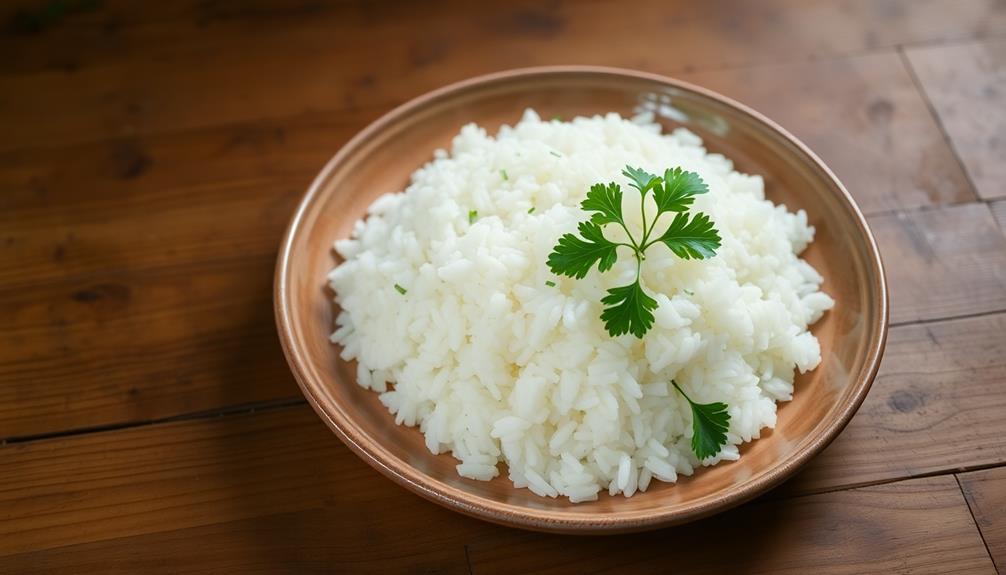
Nigerian Coconut Rice offers a delightful culinary experience that celebrates the vibrant flavors of West Africa. With its fragrant blend of coconut, spices, and tender rice, this dish is sure to delight your senses and bring a touch of tropical paradise to your table.
The final step in this recipe is the true star of the show. As the rice simmers, the coconut milk infuses it with a rich, creamy texture and a subtle sweetness that perfectly complements the savory notes. The aroma fills the air, beckoning everyone to gather around and indulge in this authentic Nigerian masterpiece.
Whether you're hosting a family gathering or seeking a unique side dish to elevate your meal, Nigerian Coconut Rice is a crowd-pleaser that will have your guests raving. Serve it alongside grilled meats, stews, or simply enjoy it on its own for a satisfying and unforgettable dining experience.
Frequently Asked Questions
What Makes Nigerian Coconut Rice Unique Compared to Other Coconut Rice Dishes?
What sets Nigerian coconut rice apart is its unique seasoning and cooking method. You'll notice bold flavors from spices like ginger, cumin, and cayenne, giving it a delightfully aromatic and slightly spicy twist compared to more traditional coconut rice dishes.
How Can I Adjust the Level of Coconut Flavor in the Dish?
To adjust the coconut flavor, you can use more or less coconut milk. Add more for a stronger coconut taste, or use less for a more subtle flavor. Experiment to find your perfect balance.
Is Nigerian Coconut Rice Suitable for Vegetarians or Vegans?
Yes, Nigerian coconut rice is suitable for vegetarians and vegans. It's made with coconut milk, rice, and vegetables, without any animal products. You can easily adapt the recipe to suit your dietary needs and preferences.
How Long Does the Dish Keep, and Can It Be Frozen?
The dish can keep for up to 3-4 days in the fridge. It can also be frozen for up to 2-3 months, though the texture may change slightly after thawing.
What Are Some Traditional Accompaniments for Nigerian Coconut Rice?
Traditionally, Nigerian coconut rice is often accompanied by stewed meat, fried plantains, and pepper soup. These hearty and flavorful dishes perfectly complement the rich, creamy, and aromatic nature of the coconut rice.
